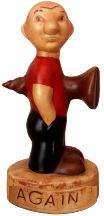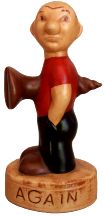 |
 The Virtual Corkscrew Museum's Weekly Newspaper |
 |
 |
 The Virtual Corkscrew Museum's Weekly Newspaper |
 |
|
Sunday, July 29, 2007 |
Number 470 |
Stage Screws
Because of their shape, these pieces are sometimes offered for sale as corkscrews. They are actually stage screws.
The stage screw design above left was offered in a c.1950 catalog from H. M. Sanders Co., Boston. Red, white, and blue finishes were available at prices ranging from $12.35 to $13.80 per dozen.
Definition: STAGE SCREW A large screw which is screwed through the "foot" of a stage brace to secure it to a strong wooden floor. Only suitable for use in theatres with non-precious wooden floors!
Frank Lippincott wrote "In utilizing my invention the screw may be inserted in the stage-floor, walls, or upper structure to provide a fixed point of attachment, so that cables, hooks, guy-ropes, &c., may be readily engaged with the ring portions and fastened to the handle, or the device may be used in connection with the various stage-settings and scenery-frames as a fastening means or coupling member." U. S. Patent No. 820,655 was issued May 15, 1906 for a "Stage Screw".
Lees' Patent
Witte's Patent
In Harry Lees' U. S. Patent No. 1,055,056 of March 4, 1913, we find a drawing of one of the uses for a stage screw. Harry shows the stage screw in use on "a scenery-brace having a foot-iron."
In U. S. Patent No. 1,103,723 issued July 14, 1914 for a "Stage Screw" Paul Witte wrote "This invention relates to wood screws and in particular a stage screw for use in connecting parts of stage scenery or in securing scenery to the stage itself."
In U. S. Patent No. 1,188,305 for a "Stage Screw", Edward Noerteman wrote "... a wood screw of the kind ordinarily employed in securing scenery to stages, and which screws must be capable of being readily and easily applied and removed." The patent was issued June 20, 1916.
Now that we've looked at four "Stage Screw" patents, the patent of James Boyn simply entitled "Screw" needs a little closer scrutiny. Boyn says his invention "relates to those commonly known as 'stage screws' and goes on to state that the primary objective of his invention is to provide such a screw. However, he continues with "A further object of this invention is to provide a screw of this class whose body portion is constructed in such a manner that it may be used as a cork screw, a screw driver, a wrench, and in various other capacities."
So thanks to Boyn, a stagehand could easily substitute a worm when his working thirst told him it was time to pop a cork.
Boyn was granted U. S. Patent No. 1,110,250 on September 8, 1914.
Smith's Patent?
Reader Kenn Cameron submitted the above photo with his query: "Do any Weekly Screw readers have more information on what appears to be another variation of the Joseph A. Smith's June 3, 1884 U. S. Patent No. 299,864. I showed these pictures to Ron Maclean, and we agreed the way the worm was attached was identical to the version shown in Fred O'Leary's book*, page 68. Unfortunately there are no markings. This is the second one I've found over the years. I'm curious to see if there are any other variations on the handle. The handle is made out of pewter. It appears the patent was not for the corkscrew, but for the way in which the twisted wire corkscrew was attached to the handle.
Smith offered this description for his invention: "... (a) designates the twisted shank, and (b) the screw, of cast-steel, hardened and tempered. The shank and screw are of one piece, the shank being bent and twisted upon itself down to the screw. I cast the handle upon the shank, as shown in the drawing ... It may be nickel-plated or otherwise finished to ornament it."
Any readers have another example or more information? email corkscrew@bullworks.net
*Corkscrews: 1000 Patented Ways to Open a Bottle
Extractor Follow-up
In last week's issue, we ran an article of Cork Retrievers. Several collectors submitted photos of retrievers in their collections.
From Bob Roger
Bob Writes: "Forged and copper: Top puller is copper or a copper alloy, so sparks will not be created. It is 12 inches long and right-handed. The bottom two are hand forged and very early, perhaps 18th Century. Both have left-handed worms, the bottom one a flat worm and the middle one a roundish cross-section. The middle one has a left and right-handed twist to the shank, and the lower one has a six-sided shank. They are 12 and 16 inches long and may have been for gun cleaning/clearing instead of packing."
"Unmarked. Lengths are 6 - 14 ½ inches. All right-handed."
"Wire Twists. Here are three different types of wire twists, all right-handed and not flexible. Lengths 8-13 inches, no markings."
"Marked Pullers. Top - BUFFUM TOOL CO. LOUISIANA MO., 6 ¼ inches long. 2nd down - "MOUND" ST. LOUIS 1 The 1 indicates the size, which is 6 ½ inches long. 3rd down - same as "MOUND" above without a size number. It is 9 ½ inches long. 4th down - DURA HOOK #1 PAT. NO. 2,066,598. It is 7 ½ inches long. Bottom - DURA HOOK PAT. NO. 2,066,598. It is 19 inches long. All but the Buffum are flexible, and all are right-handed."
"Not Packing Pullers. These are 7 and 9 inches long, right-handed worms. I got these from Peter Hoefer, and he said they were 18th Century or early 19th Century, Italian, used for wine tasting (I think to pull the spile out, get a sample, and then a new spile was driven in the hole. The hole was originally bored by a wine fret or pointeau). Note the two different styles of handle - one a single L shape, the other an attached loose bar that becomes an L shape when turned."
From Mark Woodard
Mark writes: "Here are my 4 extractors. The top 2 are unmarked. The next is marked "MOUND" ST. LOUIS with a 2 on the handle and is 10.75" long. I presume the number related to the size of the extractor. The bottom one is a 7.5" long Dura Hook although the markings are very worn. On 1 side, I can read "HOOK #1", the word DURA is probably worn off. "
From Carroll Johnson
Carroll writes: "A forged packing extractor is at the top. Perhaps the filed one is a gun cleaning tool for a pair of dueling pistols."
From Ron MacLean
Ron writes: "I have 'MOUND' ST LOUIS 3 - 15 inches long; DURA HOOK 3 - 15 inches long; DURA HOOK 2 - 11 inches long; and PAT APPLD FOR RHOPAC CHICAGO - 10.75 inches long."
Albert Mussey Johnson was issued Canadian Patent No. 280,415 on May 22, 1928. The patent was owned by the Rhopac Company and it was for "A metallic piston packing comprising a cylindrical core of rubber, a surrounding layer made up of a mixture of sheet babbitt, graphite and oil, and an outer protecting cover of fabric."
|
©2007 Don Bull, Editor |